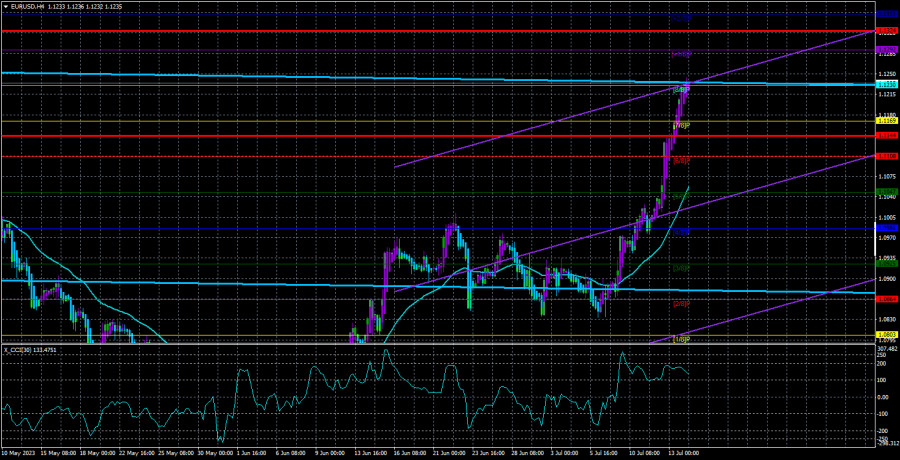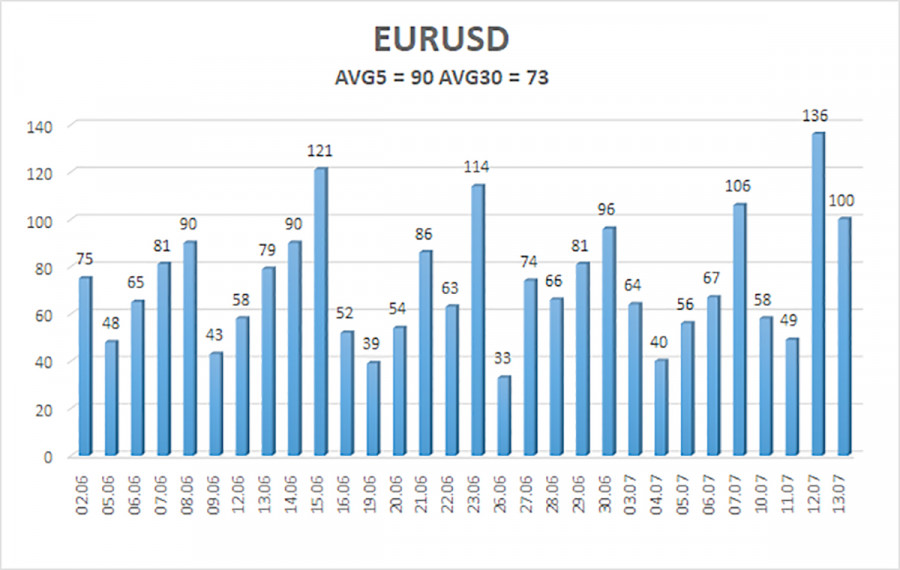

EUR/USD continued its upward movement on Thursday. Over the past few months, we have consistently drawn traders' attention to the euro's bull run. The currency has been trading at very high levels for 6 months but has failed to enter a proper downward correction. A new phase of upward movement started in July. What has changed in July that the market has once again actively started buying out the euro? Did the Federal Reserve announce the end of its tightening cycle? No, it did not. Did the ECB signal a rate hike to 6%? No, it did not. Essentially, nothing has changed. The only difference is that US inflation has dropped to 3%, but this report was released only on Wednesday, and yet the currency pair rose on Monday, Tuesday, Thursday, and even Friday. Furthermore, inflation in the US has been decreasing for a year now, so it is unlikely that a single report could surprise traders enough to cause the dollar to lose 250 pips in just four days...
Thus, the current strengthening of the euro is not driven by any specific factors or events. The euro is rising simply because it is being bought, and this trend is great for trading. The price is moving mostly in one direction almost all the time, what could be better? The CCI indicator entered overbought territory this week, and... nothing happened. This once again proves that the market pays no attention to logic. It is a Bitcoin-style movement.
Speculating on when this insane growth will end is pointless because it is not tied to any fundamental events. Let's not forget that the European economy is much weaker than the American economy, the Federal Reserve's interest rate is much higher than the ECB's rate, and the European regulator is not a wizard. Some of its officials are already doubting whether it will be necessary to raise rates in the fall. Everything indicates that the dollar should increase or at least not fall. It has been the case for six months, but now the market has once again broken free and opens long positions every day.
Yesterday, even secondary reports did not provide support for the euro. To say that the market has been reacting to the inflation report for four consecutive days is the same as discussing the outcome of the December meetings of the Federal Reserve or the ECB – it does not matter. Thus, the only option left is to trade with the trend.
Why does the euro show impressive growth?
We have previously mentioned that one can find a convincing explanation for what is happening in any unclear situation. We have noted before that there are numerous major players in the market who may carry out transactions regardless of fundamental or macroeconomic factors, not for the purpose of investment or profit, but simply because they need a particular currency to trade. Therefore, every movement should not always be driven by fundamentals. However, as soon as an inexplicable movement begins, everyone starts talking about rising risk or anti-risk sentiment. No one has been able to explain what that means. No one can explain when and under what circumstances these risk or anti-risk sentiments arise. No one discusses the strength of such a movement.
It turns out that any movement in the market can be explained using this thesis. We believe this is meaningless and unprofessional. In such situations, it is wiser to partially disregard fundamentals and pay more attention to technical analysis, which illustrates what is happening in the market right now. There simply is no other option. Everyone understands that the pair is heavily overbought and without any corrections even this week, which indicates that a decline should begin. However, the upward movement can easily continue even next week because the market owes nothing to anyone. It trades the way it needs and finds advantageous.

The 5-day average volatility of EUR/USD totals 90 pips on July 14 and is considered moderate. The price will likely be in the range between 1.1144 and 1.1324 on Friday. Heikin Ashi's reversal to the downside will indicate a bearish correction.
Support:
S1 – 1.1169
S2 – 1.1108
S3 – 1.1047
Resistance:
R1 – 1.1230
R2 – 1.1292
R3 – 1.1353
Outlook:
EUR/USD continues its horizontal upward movement. We can hold long positions with targets at 1.1292 and 1.1324 until Heikin-Ashi's reversal to the downside. Once the price consolidates below the Moving Average, we can consider selling ith targets at 1.0986 and 1.0925.
Indicators on charts:
Linear Regression Channels help identify the current trend. If both channels move in the same direction, a trend is strong.
Moving Average (20-day, smoothed) defines the short-term and current trends.
Murray levels are target levels for trends and corrections.
Volatility levels (red lines) reflect a possible price channel the pair is likely to trade in within the day based on the current volatility indicators.
CCI indicator. When the indicator is in the oversold zone (below 250) or in the overbought area (above 250), it means that a trend reversal is likely to occur soon.